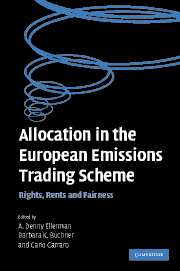Book contents
- Frontmatter
- Contents
- List of figures
- List of boxes
- List of tables
- List of contributors
- Introductory note/Foreword
- Acknowledgements
- Glossary and abbreviations
- Part I The EU ETS allocation process
- Part II Experiences from Member States in allocating allowances
- 3 United Kingdom
- 4 Germany
- 5 Denmark
- 6 Sweden
- 7 lreland
- 8 Spain
- 9 Italy
- 10 Hungary
- 11 Czech Republic
- 12 Poland
- Part III Concluding remarks and background material
- Appendix I Participants
- Appendix II The individual country outlines
- Appendix III The country tables
- Appendix IV Background material from the European Commission
- Index
5 - Denmark
Published online by Cambridge University Press: 22 September 2009
- Frontmatter
- Contents
- List of figures
- List of boxes
- List of tables
- List of contributors
- Introductory note/Foreword
- Acknowledgements
- Glossary and abbreviations
- Part I The EU ETS allocation process
- Part II Experiences from Member States in allocating allowances
- 3 United Kingdom
- 4 Germany
- 5 Denmark
- 6 Sweden
- 7 lreland
- 8 Spain
- 9 Italy
- 10 Hungary
- 11 Czech Republic
- 12 Poland
- Part III Concluding remarks and background material
- Appendix I Participants
- Appendix II The individual country outlines
- Appendix III The country tables
- Appendix IV Background material from the European Commission
- Index
Summary
Introductory background and context
This chapter presents lessons learnt in connection with the national allocation plan for Denmark (Ministry of Environment 2004). Section 1.1 outlines some particular features of the Danish energy sector and the historical CO2 emissions. Section 1.2 describes the previous experience with emissions trading in Denmark, and Section 1.3 describes the process and milestones in the production of the Danish National Allocation Plan (NAP).
Country-specific features related to emissions trading
Denmark has no hydro and no nuclear power. Historically, this has led to a relatively large share of coal in the power sector and a high per capita CO2 emission. Power and heat production are heavily integrated through the use of combined heat and power (CHP). The extensive use of district heating with CHP combined with high power plant efficiencies has led to an energy efficiency in the power and district heating sector that is among the highest in the world. The manufacturing industry and commercial sector have a comparatively low energy intensity. The domestic sector has a stable and low energy demand.
Figure 5.1 shows the total primary energy supply (TPES) by fuel types over the last twenty years. Since the early 1980s, use of natural gas and renewables has increased in the electricity and heating sectors. As a result, use of coal decreased – in particular after 1995. Oil has also decreased in the heating and electricity sector, but the decrease has been offset by an increase of its use in the transport sector.
- Type
- Chapter
- Information
- Allocation in the European Emissions Trading SchemeRights, Rents and Fairness, pp. 106 - 131Publisher: Cambridge University PressPrint publication year: 2007
- 3
- Cited by



